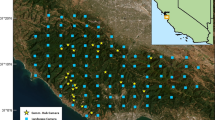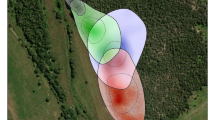Abstract
Animal signals function to elicit behaviors in receivers that ultimately benefit the signaler, while receivers should respond in a way that maximizes their own fitness. However, the best response may be difficult for receivers to determine when unreliable signaling is common. “Deceptive” alarm calling is common among tufted capuchins (Cebus apella nigritus) in competitive feeding contexts, and responding to these calls is costly. Receivers should thus vary their responses based on whether a call is likely to be reliable. If capuchins are indeed able to assess reliability, I predicted that receivers will be less likely to respond to alarms that are given during competitive feeding contexts than in noncompetitive contexts, and, within feeding contexts, that individuals inside or adjacent to a food patch will be less likely to respond to alarms than those further from the resource. I tested these predictions in a group of wild capuchins by observing the reactions of focal animals to alarm calls in both noncompetitive contexts and experimental feeding contexts. Antipredator escape reactions, but not vigilance reactions, occurred significantly less often in competitive feeding contexts than in noncompetitive contexts and individuals adjacent to food patches were more likely to respond to alarm calls than were those inside or further from food patches. Although not all predictions were fully supported, the findings demonstrate that receivers vary their behavior in a way that minimizes the costs associated with “deceptive” alarms, but further research is needed to determine whether or not this can be attributed to counterdeception.


Similar content being viewed by others
References
Blumstein, D. T., & Daniel, J. C. (2004). Yellow-bellied marmots discriminate between the alarm calls of individuals and are more responsive to calls from juveniles. Animal Behaviour, 68, 1257–1265.
Byrne, R. W., & Whiten, A. (1990). Tactical deception in primates: the 1990 database. Primate Report, 27, 1–101.
Cheney, D., & Seyfarth, R. (1988). Assessment of meaning and the detection of unreliable signals by vervet monkeys. Animal Behaviour, 36, 477–486.
Di Bitetti, M. S. (2001). Food associated calls in the tufted capuchin monkey (Cebus apella). Ph.D. dissertation, State University of New York, Stony Brook, NY
Di Bitetti, M. S., Vidal, E. M. L., Baldovino, M. C., & Benesovsky, V. (2000). Sleeping site preference in tufted capuchin monkeys (Cebus apella nigritus). American Journal of Primatology, 50, 257–274.
Fischer, J. (1998). Barbary macaques categorize shrill barks into two call types. Animal Behaviour, 55, 799–807.
Fischer, J., & Hammerschmidt, K. (2001). Functional referents and acoustic similarity revisited: the case of Barbary macaque alarm calls. Animal Cognition, 4, 29–35.
Fragaszy, D. M., Visalberghi, E., & Fedigan, L. M. (2004). The complete capuchin: The biology of the genus Cebus. Cambridge: Cambridge University Press.
Gouzoules, H., & Gouzoules, S. (2002). Primate communication: by nature honest, or by experience wise? International Journal of Primatology, 23, 821–848.
Gouzoules, H., Gouzoules, S., & Miller, K. (1996). Skeptical responding in rhesus monkeys (Macaca mulatta). International Journal of Primatology, 17, 549–568.
Hanson, M., & Coss, R. (2001). Age differences in the response of California ground squirrels (Spermophilus beecheyi) to conspecific alarm calls. Ethology, 107, 259–275.
Hare, J. F., & Atkins, B. A. (2001). The squirrel that cried wolf: reliability detection by juvenile Richardson's ground squirrels (Spermophilus richardsonii). Behavioral Ecology and Sociobiology, 51, 108–112.
Hauser, M. (1996). The evolution of communication. Cambridge: MIT Press.
Janson, C. H. (1985). Aggressive competition and individual food consumption in wild brown capuchin monkeys (Cebus apella). Behavioral Ecology and Sociobiology, 18, 125–138.
Janson, C. H. (1996). Toward an experimental socioecology of primates. In M. A. Norconk, A. L. Rosenberger, & P. A. Garber (Eds.), Adaptive radiations of neotropical primates (pp. 309–325). New York: Plenum Press.
Janson, C. H. (2007a). Experimental evidence for route integration and strategic planning in wild capuchin monkeys. Animal Cognition, 10, 341–356.
Janson, C. H. (2007b). Predator detection and the evolution of primate sociality: insights from experiments on a rain forest primate. American Journal of Physical Anthropology, S44, 136.
Koenig, A., & Borries, C. (2006). The predictive power of socioecological models: A reconsideration of resource characteristics, agonism, and dominance hierarchies. In G. Hohmann, M. M. Robbins, & C. Boesch (Eds.), Feeding ecology in apes and other primates: Ecological, physical and behavioral aspects (pp. 263–284). New York: Cambridge University Press.
Krebs, J., & Dawkins, R. (1984). Animal signals: mind-reading and manipulation. In J. Krebs & N. Davies (Eds.), Behavioural ecology: An evolutionary approach (pp. 380–402). Sunderland: Sinauer.
Martin, P., & Bateson, P. (2007). Measuring behaviour: An introductory guide. New York: Cambridge University Press.
Ramakrishnan, U., & Coss, R. (2000). Age differences in the responses to adult and juvenile alarm calls by bonnet macaques (Macaca radiata). Ethology, 106, 131–144.
Randler, C. (2005). Coots Fulica atra reduce their vigilance under increased competition. Behavioural Processes, 68, 173–178.
Rendall, D., Owren, M. J., & Ryan, M. J. (2009). What do animal signals mean? Animal Behaviour, 78, 233–240.
Rendall, D., Seyfarth, R. M., Cheney, D. L., & Owren, M. J. (1999). The meaning and function of grunt variants in baboons. Animal Behaviour, 57, 583–592.
Smith, W. (1986). An “informational” perspective on manipulation. In R. W. Mitchell & N. S. Thompson (Eds.), Deception: Perspectives on human and nonhuman deceit (pp. 71–86). Albany: SUNY Press.
Tibbetts, E. A. (2008). Resource value and the context dependence of receiver behaviour. Proceedings of the Royal Society of London. Series B, 275, 2201–2206.
van de Pol, M., & Wright, J. (2009). A simple method for distinguishing within-versus between-subject effects using mixed models. Animal Behaviour, 77, 753–758.
Wheeler, B. C. (2008). Selfish or altruistic? An analysis of alarm call function in wild capuchin monkeys, Cebus apella nigritus. Animal Behaviour, 76, 1465–1475.
Wheeler, B. C. (2009a). Monkeys crying wolf? Tufted capuchin monkeys use anti-predator calls to usurp resources from conspecifics. Proceedings of the Royal Society of London. Series B, 276, 3013–3018.
Wheeler, B. C. (2009b). An experimental analysis of alarm calling behavior in wild tufted capuchin monkeys (Cebus apella nigritus). Ph.D. dissertation, State University of New York, Stony Brook, NY.
Wheeler, B. C. (2010). Production and perception of situationally variable alarm calls in wild tufted capuchin monkeys (Cebus apella nigritus). Behavioral Ecology and Sociobiology, 64, 989–1000.
Wiley, R. H. (1994). Errors, exaggeration, and deception in animal communication. In L. A. Real (Ed.), Behavioral mechanisms in evolutionary ecology (pp. 157–189). Chicago: University of Chicago Press.
Zahavi, A., & Zahavi, A. (1997). The handicap principle: A missing piece of Darwin's puzzle. Oxford: Oxford University Press.
Zuberbühler, K., Cheney, D. L., & Seyfarth, R. M. (1999). Conceptual semantics in a nonhuman primate. Journal of Comparative Psychology, 113, 33–42.
Acknowledgments
I owe a large debt of gratitude to Charles Janson, whose work developing platform experiments with the focal group made this project possible. Andreas Koenig and Charles Janson provided much helpful advice and support during all phases of this project. Fruitful discussion was also provided by Sue Boinski, Mario Di Bitetti, Julia Fischer, John Fleagle, and Barbara Tiddi. Barbara Tiddi and Gabriele Schino also provided helpful statistical advice. Several anonymous reviewers provided helpful comments on a previous draft of the manuscript. I thank the Delegación Tecnica of the Argentine Administration of National Parks for permission to conduct research in the park, and the Centro Investigaciones Ecológicas Subtropicales for support and permission to live in the park. Thanks are due to many for assistance in the field, especially Eugenia Acevedo, Mariana Bischoff, Peter Cooper, Eugenia di Sorrentino, Rocio Prieto Gaona, Fermino Silva, Barbara Tiddi, and Eugenia Vidal. Financial support was provided by the American Society of Primatologists, the Wenner-Gren Foundation (grant no. 7244), and the National Science Foundation (DDIG no. 0550971). Pilot work was supported by grants to Charles Janson (NSF BCS-0515007 and a grant from the National Geographic Society Committee on Research and Exploration). The protocols used in this study received IACUC approval from Stony Brook University (ID nos. 2005-1448 and 2006-1448) and complied with all applicable laws of the United States and Argentina.
Author information
Authors and Affiliations
Corresponding author
Rights and permissions
About this article
Cite this article
Wheeler, B.C. Decrease in Alarm Call Response Among Tufted Capuchins in Competitive Feeding Contexts: Possible Evidence for Counterdeception. Int J Primatol 31, 665–675 (2010). https://doi.org/10.1007/s10764-010-9419-1
Received:
Accepted:
Published:
Issue Date:
DOI: https://doi.org/10.1007/s10764-010-9419-1




